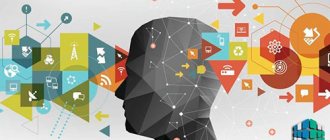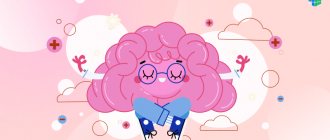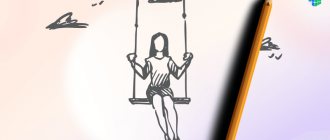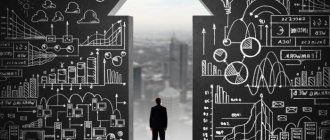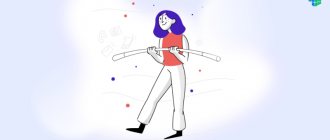Article:
A concept is defined through its subordination to a generic concept and through its specific difference from other terms subordinate to the same generic concept. There are no single concepts; they always form a system. The formation of concepts occurs in the process of people’s knowledge of the objective laws of nature and society, and the scientific research activities of mankind.
Conceptual thinking can be defined through three important skills: identifying the essence of a phenomenon or object; see the cause and predict the consequences; systematize information and build a holistic picture of the situation.
According to researchers, less than 20% of people have full-fledged conceptual thinking. These are those who studied natural and technical sciences, learned the operations of identifying essential features, categorizing and establishing cause-and-effect relationships. Those who have conceptual thinking adequately understand the real situation and draw the right conclusions.
Those who do not possess it are also confident in the correctness of their vision of the situation, but this is an illusion. In reality, they act under the influence of their emotions and subjective ideas, their forecasts do not come true, although they believe that the people and circumstances around them are to blame, and not their incorrect understanding of the situation. Even among people with higher education, more than 70% think much like children: they generalize from particular to particular, do not see essential signs and cause-and-effect relationships...
Three basic operations of conceptual thinking
Intuitive component: the ability to identify essential features, essential, most important.
Logical component: awareness of natural cause-and-effect relationships between phenomena, understanding of the essence of rules and formulas.
Conceptual categorization: establishing categorical affiliation, identifying classes, generic, level relations; ability to summarize and systematize information, build structures.
Conceptual thinking, thus, serves as a subjective form of reflection of the essential side of phenomena and objective laws of the world around us. In conceptual thinking, the analysis and systematization of information is carried out based on the essential characteristics of objects and phenomena, in contrast to the classification of objects according to any characteristics common to them, even random and external.
An essential feature differs from all other properties of an object in that it is:
- a constant attribute that is preserved during any transformation of the object;
- does not belong to characteristics perceived through the senses (such as color, shape, taste);
- deduced logically, through reasoning;
- characterizes not the object itself, but its relationship to a more general category;
- is not an individual characteristic of an object, but a property of all representatives of a given species.
The connection between phenomena, events, individual objects, subjects or their groups in conceptual thinking occurs through the establishment of hierarchical generic and objective cause-and-effect dependencies, and not any possible relationships and associations.
Training
The most effective way to develop thinking in a short time is to undergo training. I present to your attention the course “Development of Thinking” from Vikium.
You will learn:
- make the right decisions with lightning speed;
- clearly argue in disputes and convince;
- construct your speech competently and logically;
- count complex examples in your head with ease.
The course includes:
- thinking development program;
- theoretical video lectures;
- practical exercises and assignments
- simulators for the development of logic
This course will help:
- improve and speed up thinking;
- develop analytical skills;
- think critically in any situation;
- make unconventional decisions.
Determining the level of conceptual thinking using tests
The degree of development of conceptual thinking can be determined using psychological tests. The intuitive component of conceptual thinking is determined, for example, using such a test.
The child is presented with 4 pictures: squirrel, hedgehog, bunny, dog. You need to choose the extra one. A child with conceptual thinking will remove the dog because it is a domestic animal, and the rest are wild.
Other children will name insignificant signs: for example, they will remove the hedgehog because it is prickly, and the rest are soft, or the hare, because it has long ears, and the rest have small ones.
Here is another example of testing children 6–7 years old, which adults cannot always cope with. Tit, pigeon, bird, sparrow, duck. What's extra? Many people say it's a duck. Why duck? Because she's the biggest? And also a waterfowl? In fact, “bird” is a superfluous concept in this series, because it is the name of an entire class of creatures, a generalizing feature, but in order to understand this, you need to have conceptual thinking.
Lyudmila Yasyukova has adapted and for many years been using the Amthauer intelligence structure test, designed to assess the level and structure of intellectual abilities of people aged 13 to 60 years, including for the purposes of career guidance and selection. According to her data, the level of conceptual thinking of students is constantly decreasing: among students at a polytechnic university, the average score on one of the subtests in 2008 was 12.8; in 2009 - 12.7; in 2010 - 11.1; in 2011 - 9.5; in 2012 - 9.3; in 2013 - 8.9; in 2014 - 8.3.
Application in the scientific field
Here the need for unambiguous concepts is no less obvious, since the result of scientific work is largely determined by the correct interpretation of the initial data. However, it is reliably known that one concept can have slightly different meanings in a certain context.
If we turn again to the economic sector, it is not difficult to imagine the correct interpretation of the concept of market for the conditions of a country, city or region. But if you remember this same term in the context of going grocery shopping, it immediately takes on a completely different meaning.
How conceptual thinking is formed
The formation of conceptual thinking occurs in the process of people’s knowledge of the objective laws of nature and society, and the scientific research activities of mankind. Conceptual thinking is absent in primitive communities and cultures in which science and corresponding educational systems have not yet developed. Conceptual thinking does not obey the laws of age-related maturation and does not arise by itself, which is why not all adults possess it.
Conceptual thinking is the outcome of learning. Moreover, only such education in which the child studies science, because all sciences are built on a conceptual principle; the sciences reflect the objective laws of the surrounding world.
As one masters scientific knowledge, individual internal experience is rebuilt and organized in accordance with the system of objective relations that are inherent in a particular science, and reproduces its multidimensional “network of vertical and horizontal connections,” as Lev Vygotsky pointed out. The scientific knowledge a child acquires is organized into conceptual structures, and thus he gradually learns the general conceptual principle of structuring information.
Previously, the foundations of conceptual thinking began to be laid in natural history in elementary school, then botany began in the 5th grade, zoology in the 6th and 7th grades, anatomy in the 8th grade, and general biology in high school. A certain pyramid of knowledge was built: the flora and fauna, which are subject to the general laws of development. Now there is no systematic presentation, everything is mixed up - botany, the animal world, humans, and general biology. The principle of scientific presentation of information has been replaced by the principle of a kaleidoscope, changing pictures, which, according to Lyudmila Yasyukova, does not allow the child to develop conceptual thinking.
Impact on school results
The point of school education is not to impart knowledge to a child; some of it will become outdated even before he finishes school. The point of school education is to teach a child to think. Only then will he be able to live independently in the adult world.
Before school, the child does not have to perform complex mental operations every day - he either walks or plays. He does not have a structured system of thinking, since there is no need to systematically process information.
And at school there are four lessons a day, five days a week, you need to somehow summarize and systematize information. And these operations that the child uses every day will be consolidated as thinking operations.
A good level of intuitive component makes it easy to master humanitarian programs. If the intuitive component is weak, thinking as a whole remains dependent. A child can complete a task when given instructions, but gets lost if he has to figure it out on his own. He easily retells the contents of a textbook (especially in history or literature), but cannot draw up a story plan and answer questions about the text.
The logical component is responsible for the general ability to learn and the possibility of specialization in the natural sciences. If the ability to find a logical connection between phenomena is not developed, then in high school it will be difficult to study in all subjects, and the abstract thinking necessary for studying the physical and mathematical sciences will not be formed.
Conceptual categorization is necessary for systematizing scientific knowledge, for the formation of structural and linguistic abilities, literacy and the development of foreign languages. If the categorization operation is not developed, problems arise with biology and chemistry.
Higher functions, as proven by Lev Vygotsky, can compensate for lower ones, so thinking is important in a broader sense. For example, through the development of thinking, you can compensate for problems with attention and a short cycle of performance. There are also unexpected benefits. Children with more developed conceptual thinking more calmly perceive other everyday behavior and another culture. They have higher predictive abilities, so “others” are not so incomprehensible to them and do not cause feelings of anxiety or aggression.
Application in the domestic sphere
Lack of conceptual thinking in everyday life can create many difficulties for a person. The practical activity of someone who does not master this type of thinking becomes disorganized and uncertain.
A striking example is the phrase “Sidorov is on vacation.” If we interpret the word “vacation” as any absence of an employee from the workplace, then a certain amount of confusion and misleading immediately arises. Another clear illustration of the need for a conceptual form of thinking in the everyday sphere can be the usual viewing of a sports competition on TV. As a rule, the concepts “prize-winner”, “participant”, “winner” are used in the program. Without a specific and clearly defined meaning of all these terms, watching a competition is devoid of any meaning.
Ways to develop conceptual thinking
If the school curriculum does not sufficiently develop conceptual thinking, parents will have to take matters into their own hands. How can you work with a child? Here are some ideas.
Analyze objects and events , ask questions and talk together about what it consists of and what each part is needed for. What is necessary for this event, phenomenon or thing to happen/exist.
Carry out classification and systematization , giving the subject a place in the overall picture of the world. For example, a spoon is a cutlery, what other cutlery do you know? What else do we use in the kitchen? There are also dishes for cooking, for eating, and household electrical appliances. The main thing is to do this according to the main feature, and not by color or shape - underwear, street clothes, summer clothes, holiday clothes, and so on. How to determine an essential feature? It must be permanent. For example, an apple may change color, shape, size, taste, but it will always be a fruit. This is its essential feature. We deduce it logically, and do not feel it at the level of feelings. It does not denote the object itself, but its relationship to a more general category (and characterizes not one object, but the entire category).
use diagrams not only when we draw a room plan. You can schematically explain the time of day and events, the plan of action. Or, for example, what to take with you to visit your grandmother for three days - clothes according to the weather (what kind of weather might it be?) and what exactly is needed (shoes, outerwear, underwear); toys (for home, for outdoors).
Clean up the room using generalizations, for example: soldiers and military equipment are standing next to each other, but they are not the same thing. But “Why?” and “What else can you put next to it?” These are developmental questions. And by the way a child puts things in order, one can judge the consistency, consistency, and logic of his thinking.
Work with small texts. You can invite the child to choose one of two or three titles for the text, say in one sentence what the story was about, ask questions about the essence of the text (first analyze the questions, and then read and answer).
Understanding cause and effect relationships
What came first: the egg or the chicken?
When phenomena exist together, we tend to consider one of them as a cause and the other as an effect. For example, people used to believe that living beings are spontaneously generated: mice appear from dirty laundry, and flies from rotten meat. There is rotten meat, there are flies. No rotten meat, no flies. The connection between flies and rotten meat was so strong and obvious that rotten meat was considered the cause and flies the effect. The true cause of the flies—the eggs of female flies—is harder to spot, so the true cause-and-effect relationship remained unclear.
Why is conceptual thinking needed in adult life?
Adaptation to new situations
If conceptual structures have not been formed, then a person does not notice erroneous judgments, the illogicality of his own statements, finds it difficult to verify or justify conclusions, and makes decisions that do not lead to the desired result. Social intelligence is formed only on the basis of conceptual thinking.
Overcoming infantilism
The infantilism of young people, their lack of independence, which many complain about, is not due to the fact that we care about them too much. They are explained by the immaturity of conceptual thinking.
Young people, already as adults, do not understand the situation in which they find themselves, and therefore are forced to ask older colleagues, bosses or parents what to do.
They simply cannot understand the essence of the problem, they do not see why something happened and what needs to be done. In a rapidly changing world, you need to have a mindset that can analyze the situation in which a person finds himself...
Professional usefulness
Full-fledged conceptual thinking is the most important part of academic intelligence, but it is also a condition for an adequate understanding of any work and life situation and is necessary for human survival in a world where objective laws apply.
The ability to live successfully depends on how young people can understand the environment in which they live, what they need to do, and how to make the right decision. Many well-known major disasters are explained by the fact that people did not figure out what was going on in time, did not assess the situation, and did not use knowledge and logic to predict its development.
Understanding the essence
The main characteristics of phenomena are often hidden, so we try to understand phenomena through random, situational, and emotional signs.
For example, people often equate home and family education based on a situational characteristic: the place of education. But the essence of education is the goals, standards and paradigms that underlie it.
Also, many have difficulty understanding the essence of secular education. It is often even believed that the elements of student clothing determine the nature of education.
I almost always wear sunglasses. Often people around me perceive this as an extravagant style and ask why I am wearing glasses. Style is a secondary characteristic of glasses, a side effect. The essence of sunglasses is reflected in their name: they protect your eyes from the sun (at the same time from wind, dust, snow and rain). I've been asked about glasses so often that I even made a video on the topic.
View this post on Instagram
I get asked about this every day! I answer. We are talking about polarized lenses.
Posted by Kirill Karpenko (@kirill_karpenko__) Sep 15, 2021 at 3:46 PDT
